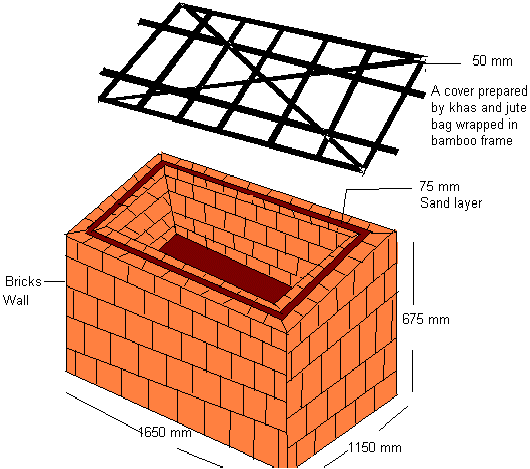Storage Methode
Full ripe tomatoes are stored at a temperature of 55°F for up to several days. Temperatures
cooler than this will cause chilling injury, producing poor colors and off flavors. Due to
improper storage, there is a loss in fresh weight of about 10-15%. This causes them to
appear shriveled and stale, thus considerably lowering their market value and consumer
acceptability. Proper storage facilities are important in stabilizing the supplies by
carrying over the produce from periods of high production to periods of low production.
Recommended storage temperature, Relative Humidity (RH) and average storage life for tomato: -
| Vegetables | Temp 0C | RH (%) | Storage life (weeks) |
|---|---|---|---|
| Tomato, unripe | 8.0-10.0 | 85-90 | 4.5 |
| Tomato, ripe | 7.2 | 90 | 1 |
Following are the methods of storage of tomato: -
- Low temperature storage
This is a time tested reliable method used for retention of freshness and extending shelf life of fresh produce as it reduces rate of respiration and thermal decomposition. Chilling injury may erode the quality of fruits if storage temperature is less than 12.50C.
- Ethylene treatment
By treating ethylene either as a dip treatment or gaseous exposure using Etherl as a source of ethylene, uniform accelerated ripening can be obtained. Further, by removing the ethylene produced by fruit with the use of ethylene absorbent either prepared indigenously or by use of ‘purafil’ (commercial form of ethylene absorbent), significant extension of shelf life.
- Evaporative cooling of tomato
Evaporation of moisture from tomato causes wilting and shriveling, resulting in weight loss. The process of evaporative cooling is an adiabatic exchange of heat when ambient air is passed through a saturated surface to obtain low temperature and high humidity, which are desirable for extending the storage life of tomato.
- MAS using silicone membrane
It is controlled ventilation system, which regulates the gas levels in the storage environment by recycling on selective gas permeation. The membrane makes use of ability of the polymer to allow the selective passage of gases at different rates according to their physical and chemical properties.
Packaging
Tomatoes may be packed in a variety of containers depending on the intended market. Customarily, individual tomatoes packed in following containers.
Vine-Ripened In flat layer carton basket (bamboo, wooden etc.)
Mature Green fruits Pack loose in carton
Plastic crates can be conveniently stacked one on the other and a contoured rim keeps the product safe and natural and allow sufficient air circulation.
Cold storage
Low cost cool chamber
This
low cost cool chamber is used for vegetables and fruits to store duration. It is prepared
by using available local materials viz. Bricks, grass, jute bags/gunny bags, bamboo and
sand. It keeps fruits fresh and attractive and without shrinkage upto 3-4 days. It is
based on principle that coolness occurs after evaporation. A sand layer kept wet by
sprinkling water twice in a day and on bricks wall once in a day. A structure of low cost
cool chamber is given in the following diagram.

The progressive increase in the productivity of the perishable commodities like tomato has
necessitated the development of cold storage facilities in the growing as well as around
the consuming centres to prolong their shelf life in one or the other form to cater to the
needs of the people. The development of cold storage industries has therefore an important
role to play in reducing the wastage of the perishable commodities and thus providing
remunerative prices to the growers. Cold storages are used for storage of different fruits
and vegetables depending on the season and/or storage of different fruits and vegetables
at the same time.
The design of Cold Storage largely depends on
• Product to be stored
• Temperature and humidity conditions to be maintained
• Quantity of the product
• Period of Storage
In case of tomato the storage temperature that requires is different for ripe and for mature
(greenish–yellow) variety of fruits. For ripe tomato’s the storage temperature
is 40 to 450F and the cold storage life that requires is about 1 to 1½ weeks.
For mature (greenish-yellow) tomato’s storage temperature required is about 55 to 600F
and its cold storage life is about 3 to 4 weeks. Tomatoes should not be stored in
temperature lower than 400F because they show the tendency to break down. Green
but matured tomatoes can be ripened satisfactorily with the development of attractive red
colour by storing at 60 to 700F.
Financial assistance for cold storage is given by National Horticulture Board. Beneficiaries are
co-operative societies, agricultural produce and sale committee, agricultural industry
co-operatives, and farmers’ co-operatives. Capacity of cold storage should be 5,000
Mt. and considering expansion of cold storage should be not be more than 2 crores.
Percentage of capital investment for cold storage is as follows:
• Share from NHB – 25%
• From NABARD/Traders bank – 50% (loan)
• From NCDC – amount upto 50 lakh (north eastern states Rs.60 lakh) 33%
• Co-operatives owned share – 10%
• For co-operative basis cold storage, permission is required from National Co-operative Development
Cooperation.
For detailed information:
National Horticulture Board (NHB),
Agricultural Ministry, Govt. of India,
85 institutional area section – 18
Gurgaon-122015